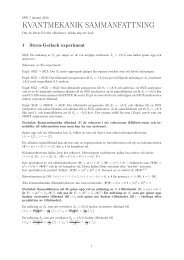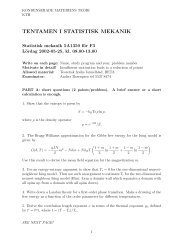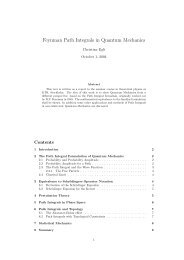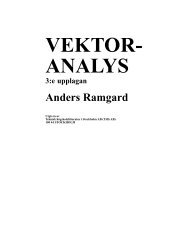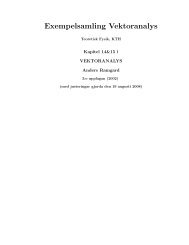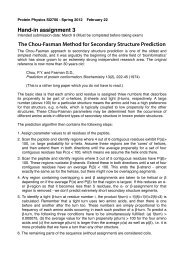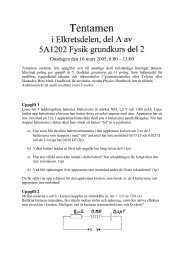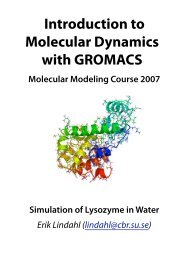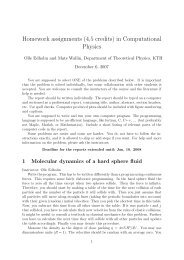[VAR]=Notes on variational calculus
[VAR]=Notes on variational calculus
[VAR]=Notes on variational calculus
Create successful ePaper yourself
Turn your PDF publications into a flip-book with our unique Google optimized e-Paper software.
October 10, 2006<br />
Introducti<strong>on</strong> to variati<strong>on</strong>al <strong>calculus</strong>: Lecture notes 1<br />
Edwin Langmann<br />
Mathematical Physics, KTH Physics, AlbaNova, SE-106 91 Stockholm, Sweden<br />
Abstract<br />
I give an informal summary of variati<strong>on</strong>al <strong>calculus</strong> (complementary to the<br />
discussi<strong>on</strong> in the course book).<br />
Aims (what I hope you will get out of these notes):<br />
(i) know a few important examples of variati<strong>on</strong>al problem and why it is useful to know<br />
how to solve then,<br />
(ii) how to solve certain standard types of variati<strong>on</strong>al problems,<br />
(iii) reformulate ODE and PDE problem as variati<strong>on</strong>al problems, and, in particular,<br />
know Hamilt<strong>on</strong>’s principle,<br />
(iv) the chapter <strong>on</strong> variati<strong>on</strong>al <strong>calculus</strong> in the course book is rather brief, and thus the<br />
present notes should provide a more detailed presentati<strong>on</strong> of the theory needed to solve<br />
the variati<strong>on</strong>al problems in the exercise classes.<br />
WARNING: Beware of typos: I typed this in quickly. If you find mistakes please<br />
let me know by email.<br />
1. Examples of variati<strong>on</strong>al problems<br />
We now formulate a few standard such problems. We first will give an intuitive descripti<strong>on</strong><br />
and then a mathematical formulati<strong>on</strong>. Further below we will discuss methods<br />
how to solve such problems.<br />
Problem 1: Find the shortest path in the plane c<strong>on</strong>necting two different points A and<br />
B.<br />
Of course we intuitively know the answer to this problem: the straight line c<strong>on</strong>necting<br />
these points. However, is instructive to give a precise mathematical formulati<strong>on</strong> of<br />
this: Let (x 0 , y 0 ) and (x 1 , y 1 ), x 0 < x 1 , be the Cartesian coordinates of the points A<br />
1 I thank Christian Adåker for pointing our several typos.<br />
1
and B, and y(x) a C 2 functi<strong>on</strong>, 2 x 0 ≤ x ≤ x 1 , such that y(x i ) = y i for i = 0, 1. Then<br />
y(x) describes a path c<strong>on</strong>necting A and B, and the length of this path is<br />
Using dy = y ′ (x)dx we get<br />
L =<br />
∫ B<br />
A<br />
L[y] =<br />
ds =<br />
∫ x1<br />
∫ x1<br />
x 0<br />
√<br />
dx2 + dy 2 .<br />
We now can rephrase Problem 1 in a mathematical language:<br />
x 0<br />
√<br />
1 + y′ (x) 2 dx. (1)<br />
Problem 1’: Determine the real valued C 2 functi<strong>on</strong> y <strong>on</strong> [x 0 , x 1 ] (i.e. y is given by<br />
y(x) with x in [x 1 , x 0 ]), fixed at the end points: y(x i ) = y i for i = 0, 1, and such that<br />
the integral in (1) is minimal.<br />
The integral in (1) is an example of a functi<strong>on</strong>al: We have a set of functi<strong>on</strong>s F, i.e.,<br />
the set of all C 2 functi<strong>on</strong> y <strong>on</strong> the interval [x 0 , x 1 ] such that y(x i ) = y i for i = 0, 1,<br />
and L[y] is assigns to each y in F a real number. Moreover, Problem 1’ is a variati<strong>on</strong>al<br />
problem: we look for the functi<strong>on</strong> in F minimizing the functi<strong>on</strong>al L[y].<br />
In general, a functi<strong>on</strong>al is a mapping that assigns to each element in some<br />
functi<strong>on</strong> space a real number, and a variati<strong>on</strong>al problem amounts to searching<br />
for functi<strong>on</strong>s which are an extremum (minimum, maximum, or saddle<br />
points) of a given functi<strong>on</strong>al.<br />
In these notes we restrict ourselves to methods allowing to find extrema, and I will<br />
not discuss how <strong>on</strong>e can determine if a known extremum is a minimum, a maximum,<br />
or a saddle points. One reas<strong>on</strong> for that is that there is no general, simple method<br />
available for that, another that in many variati<strong>on</strong>al problems it is not so interesting<br />
to know this. Fortunately, in some important variati<strong>on</strong>al problems it is obvious (by<br />
some special reas<strong>on</strong>s) what kind of extremum <strong>on</strong>e has: for example, in Problem 1 any<br />
extremum must be a local minimum (since <strong>on</strong>e always can always increase the length<br />
of a given the path by a further deformati<strong>on</strong>), and a similar remark applies to Problem<br />
2 below.<br />
While in the case above it is possible to “guess” the soluti<strong>on</strong>, it is easy to formulate<br />
similar problems where the soluti<strong>on</strong> no l<strong>on</strong>ger is obvious:<br />
2 A C 2 functi<strong>on</strong> is <strong>on</strong>e that is can be differentiated twice. We will not be very careful about such<br />
technicalities and assume that all functi<strong>on</strong>s are sufficiently “nice” that all derivatives we write are are<br />
well-defined: We <strong>on</strong>ly write “C 2 ” at some places to remind us that there is some c<strong>on</strong>diti<strong>on</strong> <strong>on</strong> the<br />
functi<strong>on</strong>s c<strong>on</strong>cerning differentiability. A more precise mathematical discussi<strong>on</strong> would discuss this in<br />
more depth.<br />
2
Problem 2: Find the shortest/extremal path <strong>on</strong> a given surface embedded in three<br />
dimensi<strong>on</strong>s which c<strong>on</strong>nects two given points A and B <strong>on</strong> this surface.<br />
To formulate this problem in a mathematical language I assume the surface is given<br />
by a C 2 functi<strong>on</strong> z = z(x, y) in Cartesian coordinates, and that x i , y i , z i = z(x i , y i ) for<br />
i = 0 and i = 1 are the Cartesian coordinates of the two points A and B, respectively.<br />
Then the path c<strong>on</strong>necting A and B can be parametrized by a vector valued functi<strong>on</strong><br />
x(t) = (x(t), y(t)), 0 ≤ t ≤ 1, and such that x(0) = x 0 = (x 0 , y 0 ) and x(1) = x 1 =<br />
(x 1 , y 1 ). The length of such a path is<br />
L =<br />
∫ B<br />
A<br />
ds =<br />
∫ B<br />
A<br />
√<br />
dx2 + dy 2 + dz 2 ,<br />
and using dx = x ′ (t)dt, dy = y ′ (t)dt, and dz = [z x (x(t), y(t))x ′ (t)+z y (x(t), y(t))x ′ (t)]dt<br />
we get<br />
∫ 1 √<br />
L[x] = x ′ (t) 2 + y ′ (t) 2 + [z x (x(t), y(t))x ′ (t) + z y (x(t), y(t))x ′ (t)] 2 dt. (2)<br />
0<br />
L[x] again is a functi<strong>on</strong>al (now <strong>on</strong> a different space of functi<strong>on</strong>s), and mathematically<br />
we again have a variati<strong>on</strong>al problem, but now of a functi<strong>on</strong> with values in R 2 :<br />
Problem 2’: Find the C 2 functi<strong>on</strong> x <strong>on</strong> the interval [0, 1] with values in (a subset<br />
of) R 2 (i.e. x is given by x(t) = (x(t), y(t)) with t in [0, 1]), fixed at the end points:<br />
x(0) = x 0 and x(1) = x 1 , and which minimizes the functi<strong>on</strong>al in (2).<br />
The following is an example of a variati<strong>on</strong>al problem for a functi<strong>on</strong> in two variables:<br />
Problem 3: A homogeneous membrane is fixed in a given frame (which is not even).<br />
Find the shape of the membrane.<br />
A possible shape of the membrane can be described by a functi<strong>on</strong> u(x) where x =<br />
(x, y) is a point in a two dimensi<strong>on</strong>al domain Ω, 3 where the boundary ∂Ω parametrizes<br />
the frame where u(x) is fixed: u(x) <strong>on</strong> ∂Ω equals some given functi<strong>on</strong>s α(x). [To have a<br />
specific example: assume that the membrane is a circular disc of radius R. The u(x) is<br />
a functi<strong>on</strong> defined for r < R such that u(r)| r=R = α(θ) where (x, y) = r(cos(θ), sin(θ))<br />
are polar coordinates.]<br />
The physical principle determining the shape of the membrane is: “the potential<br />
energy is a minimum”. The potential energy of a homogeneous membrane can be<br />
assumed to the proporti<strong>on</strong>al to is area,<br />
∫ ∫ √<br />
A[u] = dS = 1 + u x (x, y) 2 + u y (x, y) 2 dxdy (3)<br />
Ω<br />
Ω<br />
3 To be mathematically precise we should specify further what kinds of Ω we allow: the boundary<br />
should be a nice curve (which is differentiable) etc., but for simplicity we will ignore such technicalities<br />
here and in the following.<br />
3
(since, to increase the area, <strong>on</strong>e needs to stretch the membrane, which increases its<br />
potential energy; see our course book for a more detailed motivati<strong>on</strong>); here and in<br />
the following, subscriped variables indicate differentiati<strong>on</strong>, e.g. u x = ∂u/∂x etc. For<br />
membrane shapes which do not deviate much from the flat membrane u = 0 <strong>on</strong>e can<br />
approximate this functi<strong>on</strong>al by expanding the square root in a power series and <strong>on</strong>ly<br />
taking the leading n<strong>on</strong>-trivial terms, A ≈ ∫ [1+ 1 2 (u2 x+u 2 y)]dxdy. Dropping the irrelevant<br />
c<strong>on</strong>stant term ∫ dxdy we get the following (approximate) energy functi<strong>on</strong>al,<br />
∫<br />
J[u] =<br />
Ω<br />
1<br />
2 ∇u(x)2 d 2 x =<br />
We thus have the following mathematical problem:<br />
∫<br />
Ω<br />
1<br />
2 [u x(x, y) 2 + u y (x, y) 2 ]dxdy. (4)<br />
Problem 3’: Find the real valued functi<strong>on</strong>s u <strong>on</strong> the domain Ω in R 2 which equals to<br />
the functi<strong>on</strong> α <strong>on</strong> ∂Ω and which minimizes the functi<strong>on</strong>al in (4).<br />
The following is a famous variati<strong>on</strong>al problem with a c<strong>on</strong>straint given by a functi<strong>on</strong>al:<br />
Problem 4: Find shape of a homogeneous chain fixed in the two end points in the<br />
earth gravitati<strong>on</strong>al field.<br />
We can model the chain by a functi<strong>on</strong> y(x), x 0 ≤ x ≤ x 1 , where (x i , y i = y(x i ))<br />
for i = 0, 1 the the two fixed end points. The physical principle determining the shape<br />
is again: “the potential energy is a minimum”. We thus need to find a mathematical<br />
expressi<strong>on</strong> for the potential energy: we can think the the chain as a collecti<strong>on</strong> of small<br />
parts labeled by x: each part has the length ds = √ 1 + y ′ (x) 2 dx and mass dm = ρds<br />
where ρ is the mass density (in kg/m) of the chain. The potential energy of such part<br />
is gy(x)dm = gρy(x)ds, and thus the total energy of the chain is<br />
E pot = ρg<br />
∫ x1<br />
x 0<br />
y(x)ds.<br />
It is important to note that the length of the chain is<br />
L =<br />
∫ x1<br />
and when searching for the functi<strong>on</strong> minimizing the potential energy we <strong>on</strong>ly can allow<br />
those where L equals the given length L 0 of the chain:<br />
x 0<br />
Problem 4’: Find the real-valued functi<strong>on</strong> y <strong>on</strong> [x 0 , x 1 ] fixed at the end points, y(x i ) =<br />
y i for i = 0, 1, and minimizing the functi<strong>on</strong>al<br />
J[y] =<br />
∫ x1<br />
ds,<br />
x 0<br />
y(x) √ 1 + y ′ (x) 2 dx (5)<br />
4
under the c<strong>on</strong>straint<br />
for a given L 0 .<br />
L[y] =<br />
∫ x1<br />
There are many more examples, of course...<br />
x 0<br />
√<br />
1 + y′ (x) 2 dx = L 0 (6)<br />
2. Method of soluti<strong>on</strong><br />
As discussed, a variati<strong>on</strong>al problem amounts to extremizing some functi<strong>on</strong>al. The<br />
standard method to solve such a problem is to c<strong>on</strong>vert it into a ODE or PDE problem. It<br />
also can be useful to reformulate a given ODE or PDE problem as variati<strong>on</strong>al problem:<br />
this can provide a starting point for an approximate soluti<strong>on</strong>.<br />
2.1 Functi<strong>on</strong>als depending <strong>on</strong> <strong>on</strong>e functi<strong>on</strong> of <strong>on</strong>e variable.<br />
In this secti<strong>on</strong> I discuss in detail the simples kind of variati<strong>on</strong>al problems. All<br />
essential ideas behind variati<strong>on</strong>al <strong>calculus</strong> appear already here, and the generalizati<strong>on</strong> of<br />
these ideas to more complicated cases in the following secti<strong>on</strong>s is quite straightforward<br />
(I will be rather brief there).<br />
Problem 1 above is a (rather trivial) example of the following kind of problem:<br />
Problem A: Given a functi<strong>on</strong>al<br />
J[u] =<br />
∫ x1<br />
x 0<br />
F(u(x), u ′ (x), x)dx (7)<br />
where F = F(u, u ′ , x) is a C 2 functi<strong>on</strong> of three real variables. Find the functi<strong>on</strong>(s) u<br />
<strong>on</strong> the interval [x 0 , x 1 ] fixed at the end points, u(x i ) = y i for i = 0, 1, and extremizing<br />
this functi<strong>on</strong>al.<br />
To avoid c<strong>on</strong>fusi<strong>on</strong> I should make clear here that I slightly abuse notati<strong>on</strong> and use<br />
the symbols u and u ′ in two different meanings: firstly, in F(u, u ′ , x) as a symbols<br />
for the first and sec<strong>on</strong>d variable of the functi<strong>on</strong> F, and sec<strong>on</strong>dly, as symbol for the<br />
functi<strong>on</strong> u <strong>on</strong> [x 0 , x 1 ] and its derivative. This is not the same, and a pedant would have<br />
written F = F(r, p, x) and used different symbols. However, <strong>on</strong>ce <strong>on</strong>e has thought this<br />
through carefully there is no more need to make such distincti<strong>on</strong>s: as we will see, it<br />
is quite useful to be somewhat vague about what <strong>on</strong>e means by u and u ′ since this<br />
avoids lengthy notati<strong>on</strong>. However, I know that this “identifying u with u(x) and u ′<br />
with u ′ (x)” which is used in many physics texts (and here) can be quite c<strong>on</strong>fusing for<br />
beginners, and I hope my remarks here and below will help to avoid this c<strong>on</strong>fusi<strong>on</strong>.<br />
(Similar remarks apply to my discussi<strong>on</strong>s of other variati<strong>on</strong>al problems below: in these<br />
cases I will also abuse notati<strong>on</strong> in a similar manner without further comments.)<br />
Below I derive and (try to) explain the following important<br />
5
Fact A: All soluti<strong>on</strong>s of the variati<strong>on</strong>al Problem A above satisfy the following so-called<br />
Euler-Lagrange equati<strong>on</strong>s,<br />
∂F<br />
∂u(x) − d<br />
dx<br />
with the boundary c<strong>on</strong>diti<strong>on</strong>s y(x i ) = y i for i = 0, 1.<br />
∂F<br />
∂u ′ (x) = 0 (8)<br />
Remarks <strong>on</strong> notati<strong>on</strong>: A few important remarks are in order here: as discussed,<br />
the functi<strong>on</strong> F depends <strong>on</strong> three variables: F = F(u, u ′ , x), and in the integrand<br />
in (7) the first variable u is replaced by u(x) and the sec<strong>on</strong>d variable u ′ by u ′ (x). 4<br />
Then ∂F means F ∂u(x) u(u(x), u ′ (x), x) (partial derivative of F(u, u ′ , x) with respect to<br />
the first variable, and replacing u by u(x) and u ′ by u ′ (x)), and similarly ∂F means<br />
∂u ′ (x)<br />
F u ′(u(x), u ′ (x), x). Thus if, e.g.,<br />
then<br />
F = F(u, u ′ , x) = (u ′ ) 2 + xu 3<br />
∂F<br />
∂u(x) = 3xu(x)2 ,<br />
∂F<br />
∂u ′ (x) = 2u′ (x).<br />
It is also important to distinguish partial and total derivative here: we have<br />
d ∂F<br />
dx ∂u ′ (x) = d<br />
dx<br />
∂F(u(x), u ′ (x), x)<br />
∂u ′ (x)<br />
=<br />
∂ 2 F<br />
∂u(x)∂u ′ (x) u′ (x) +<br />
∂F<br />
∂u ′ (x) 2u′′ (x) +<br />
∂2 F<br />
∂x∂u ′ (x)<br />
etc. If you find this c<strong>on</strong>fusing I recommend that you try to use the more careful<br />
notati<strong>on</strong> when trying to understand the derivati<strong>on</strong> below — I trust that you will so<strong>on</strong><br />
be c<strong>on</strong>vinced that the (comm<strong>on</strong>) abuse of notati<strong>on</strong> I use is much more c<strong>on</strong>venient.<br />
Derivati<strong>on</strong> of the Fact above. Step I: The idea is to c<strong>on</strong>sider a small variati<strong>on</strong> the<br />
the functi<strong>on</strong>, change y(x) to a functi<strong>on</strong>s y(x)+εη(x) where ε is a “small” parameter and<br />
η(x) is a “small variati<strong>on</strong>”. Since the end points are fixed we <strong>on</strong>ly c<strong>on</strong>sider functi<strong>on</strong>s<br />
η(x) such that<br />
η(x i ) = 0 for i = 0, 1. (9)<br />
In general, the change of the functi<strong>on</strong>al by this variati<strong>on</strong>:<br />
δJ = J[y + εη] − J[y],<br />
will be proporti<strong>on</strong>al to ε. However, if y is an extremum of J[y] then the variati<strong>on</strong> will<br />
vanish faster. Thus, the functi<strong>on</strong> y <strong>on</strong> [x 0 , x 1 ] with fixed end points is an extremum of<br />
the functi<strong>on</strong>al in (7) if<br />
d<br />
dε J[y + εη] ∣<br />
∣∣∣ε=0<br />
= 0 (10)<br />
4 A pedant would have written: “...F = F(r, p, x) . . . r by u(x) . ..p by u ′ (x).”<br />
6
for all η <strong>on</strong> [x 0 , x 1 ] such that η(x i ) = 0 for i = 0, 1.<br />
Analogy providing additi<strong>on</strong>al motivati<strong>on</strong>: It might be useful at this point to recall a<br />
similar problem which you know very well: Find the extremal points of a C 2 functi<strong>on</strong><br />
f(x) in N variables, x = (x 1 , x 2 , . . .,x N ). To check if some point x is an extremum<br />
we can “go a little away from this point” and check how the functi<strong>on</strong> changes: x is<br />
extremum if, for an arbitrary vector η, [f(x + εη) − f(x)]/ε vanishes as ε → 0 or,<br />
equivalently, if<br />
d<br />
dε f(x + εη) ∣<br />
∣∣∣ε=0<br />
= 0 for all η ∈ R N .<br />
Note that η specifies the directi<strong>on</strong> in which “we go away from the point x”, and to<br />
know if we have an extremum we need to check all possible directi<strong>on</strong>s.<br />
By the chain rule this is equivalent to the following well-known necessary c<strong>on</strong>diti<strong>on</strong><br />
for extremal points, of course: ∇f(x) = 0 (i.e., ∂f(x)/∂x j = 0 for j = 1, 2, . . ., N).<br />
Derivati<strong>on</strong> of the Fact above. Step II: We now show how to derive (8) from (10): We<br />
compute (to come from the first to the sec<strong>on</strong>d line below we interchange differentiati<strong>on</strong><br />
with respect to ε and integrati<strong>on</strong>, and we use the chain rule of differentiati<strong>on</strong>)<br />
∣<br />
d ∣∣∣ε=0<br />
dε J[y + εη] = d dε<br />
=<br />
∫ t1<br />
∫ t1<br />
= ∂F<br />
∂u ′ (x) η(x) ∣ ∣∣∣<br />
x 1<br />
t 0<br />
F(u(x) + εη(x), u ′ (x) + εη ′ (x), x)dx| ε=0<br />
t 0<br />
[ ∂F<br />
∂u(x) η(x) +<br />
∫ x1<br />
+<br />
x=x 0 x 0<br />
∂F<br />
∂u ′ (x) η′ (x)<br />
} {{ }<br />
= d<br />
dx ( ∂F<br />
∂u ′ (x) η′ (x))−η(x) d<br />
dx<br />
η(x)<br />
( ∂F<br />
∂u(x) − d<br />
dx<br />
∂F<br />
∂u ′ (x)<br />
∂F<br />
∂u ′ (x)<br />
]<br />
dx<br />
)<br />
dx (11)<br />
which must hold true for every C 2 functi<strong>on</strong> η such that η(x i ) = 0 for i = 0, 1. The key<br />
step here was a partial integrati<strong>on</strong> so that the integrand is of the form η(x) × (· · ·),<br />
and by that we get a boundary term (the first term). Since η(x i ) = 0 for i = 0, 1 this<br />
boundary term vanishes for all “allowed” variati<strong>on</strong>al functi<strong>on</strong>s η, and we can c<strong>on</strong>clude<br />
that (10) holds true if and <strong>on</strong>ly if (8) holds true. The completes our derivati<strong>on</strong> of the<br />
Fact above.<br />
Remark: In the last step we used the following fact: The integral<br />
∫ x1<br />
x 0<br />
η(x)F(x)dx<br />
vanishes for all C 2 functi<strong>on</strong>s η <strong>on</strong> [x 0 , x 1 ] if and <strong>on</strong>ly if F(x) = 0. This is very plausible:<br />
take a sequence of functi<strong>on</strong>s η(x) c<strong>on</strong>verging to δ(x − x 0 ), and we get F(x 0 ) → 0 for<br />
arbitrary x 0 (strictly speaking this fact requires a more careful proof which is bey<strong>on</strong>d<br />
the scope of my notes).<br />
7
Boundary c<strong>on</strong>diti<strong>on</strong>s. Above we c<strong>on</strong>sidered a variati<strong>on</strong>al problem where the allowed<br />
functi<strong>on</strong>s were fixed at the end points. There are other such problems where this is not<br />
the case, and then <strong>on</strong>e also gets Euler-Lagrange equati<strong>on</strong>s but with different boundary<br />
c<strong>on</strong>diti<strong>on</strong>s. The derivati<strong>on</strong> of the Euler-Lagrange equati<strong>on</strong>s above is important since<br />
it also shows how the correct boundary c<strong>on</strong>diti<strong>on</strong>s are. To show that I c<strong>on</strong>sider the<br />
derivati<strong>on</strong> of the following variant of Fact A above:<br />
Fact B: All functi<strong>on</strong>s u(x) extremizing the functi<strong>on</strong>al J[u] in (7) (without any c<strong>on</strong>straints<br />
at the end points!) are soluti<strong>on</strong>s of the Euler-Lagrange equati<strong>on</strong>s in (8) with<br />
the boundary c<strong>on</strong>diti<strong>on</strong>s<br />
∂F<br />
∂F<br />
∂u ′ (x) ∣ = 0,<br />
x=x0<br />
∂u ′ (x) ∣ = 0. (12)<br />
x=x1<br />
This is easy to understand from the computati<strong>on</strong> in (11): the boundary term in<br />
the last line now no l<strong>on</strong>ger vanishes automatically (since η(x 0 ) and η(x 1 ) can now be<br />
arbitrary), and to have it zero we have to require (12). Of course, <strong>on</strong>e could also have<br />
a variati<strong>on</strong>al problem where η(x 0 ) is fixed but η(x 1 ) is arbitrary - in this case we <strong>on</strong>ly<br />
get the sec<strong>on</strong>d c<strong>on</strong>diti<strong>on</strong> in (12), etc.<br />
Remark <strong>on</strong> how to solve such Euler-Lagrange equati<strong>on</strong>s: In general, the Euler-<br />
Lagrange equati<strong>on</strong> in (8) is a ODE of order 2 (since ∂F/∂u ′ (x) typically c<strong>on</strong>tains some<br />
power of u ′ (x), which, when differentiated, gives a term u ′′ (x)). The general soluti<strong>on</strong><br />
of this equati<strong>on</strong> thus c<strong>on</strong>tains two arbitrary c<strong>on</strong>stant which need to be fixed by two<br />
c<strong>on</strong>diti<strong>on</strong>s: either the c<strong>on</strong>diti<strong>on</strong>s in Fact A above, or otherwise the c<strong>on</strong>diti<strong>on</strong>s in Fact<br />
B.<br />
Anyway, solving a 2nd order ODE is not always easy, and there are two important<br />
special cases where the problem can be simplified to a 1st order ODE:<br />
Fact C: (a) For a functi<strong>on</strong> F = F(u ′ (x), x) independent of u(x), the Euler-Lagrange<br />
equati<strong>on</strong>s in (8) are equivalent to<br />
for an arbitrary integrati<strong>on</strong> c<strong>on</strong>stant C.<br />
∂F<br />
∂u ′ (x) = C (13)<br />
(b) For a functi<strong>on</strong> F = F(u(x), u(x)) independent of x, the Euler-Lagrange equati<strong>on</strong>s<br />
in (8) are implied by<br />
u ′ ∂F<br />
(x)<br />
∂u ′ (x) − F = C (14)<br />
for an arbitrary integrati<strong>on</strong> c<strong>on</strong>stant C.<br />
8
In these two cases we <strong>on</strong>ly need to solve a 1st order ODE which is a lot simpler.<br />
The proof of this is simple: For (a) we note that F being independent of u(x) means<br />
that ∂F/∂u(x) = 0 and thus (8) becomes<br />
d ∂F<br />
dx ∂u ′ (x) = 0.<br />
equivalent to (13). To prove (b) we differentiate (14) with respect to x:<br />
(<br />
)<br />
d<br />
u ′ ∂F<br />
(x)<br />
dx ∂u ′ (x) − F = 0,<br />
and by a simple computati<strong>on</strong> using the chain rule we see that this is equivalent to<br />
u ′′ ∂F<br />
(x)<br />
∂u ′ (x) + u′ (x) d ∂F<br />
dx ∂u ′ (x) −<br />
∂F<br />
∂u(x) u′ (x) −<br />
∂F<br />
∂u ′ (x) u′′ (x) = 0<br />
where we used ∂F/∂x = 0. The terms proporti<strong>on</strong>al to u ′′ (x) cancel, and pulling out the<br />
comm<strong>on</strong> factor u ′ (x) in the two remaining terms we get the Euler-Lagrange equati<strong>on</strong>s<br />
in (8).<br />
I stress that Fact C is important for solving many examples. To illustrate this I<br />
c<strong>on</strong>sider the following example: Extremize the functi<strong>on</strong>al<br />
S[x] =<br />
∫ t1<br />
( m<br />
)<br />
t 0<br />
2 x′ (t) 2 − V (x(t), t) . (15)<br />
As I discuss below, this is the acti<strong>on</strong> functi<strong>on</strong>al for a particle with mass m > 0 moving<br />
in x-directi<strong>on</strong> and in an external potential V (x, t) depending <strong>on</strong> positi<strong>on</strong> and time t.<br />
The Euler-Lagrange equati<strong>on</strong>s in this example are nothing but Newt<strong>on</strong>’s equati<strong>on</strong>s,<br />
mx ′′ ∂V (x(t), t)<br />
(t) = −<br />
∂x(t)<br />
(16)<br />
(check that!). Moreover, in case V (x, t) = V (x) is independent of t then Fact C (b)<br />
above implies that<br />
m<br />
2 x′ (t) 2 + V (x(t)) = C, (17)<br />
which is nothing but energy c<strong>on</strong>servati<strong>on</strong>. This is useful since the latter ODE can be<br />
solved (in principle) by separati<strong>on</strong>:<br />
∫<br />
dx<br />
√ = t + c<strong>on</strong>st.<br />
2<br />
(C − V (x)) m<br />
This you knew before: the energy of a system is c<strong>on</strong>served <strong>on</strong>ly for potentials which<br />
do not explicitly depend <strong>on</strong> time.<br />
9
For further examples see the course book.<br />
2.2 Functi<strong>on</strong>als depending <strong>on</strong> several functi<strong>on</strong>s of <strong>on</strong>e variable.<br />
Problem 2 above is a special case of the following generalizing Problem A above:<br />
Fact D: C<strong>on</strong>sider the following functi<strong>on</strong>al<br />
J[x] =<br />
∫ t1<br />
t 0<br />
F(x(t),x ′ (t), t)dt (18)<br />
where x = (x 1 , x 2 , . . .,x N ) is a collecti<strong>on</strong> of N functi<strong>on</strong>s (or equivalently, a functi<strong>on</strong><br />
with values in R N ) and F = F(x,x ′ , t) a C 2 functi<strong>on</strong> of 2n + 1 variables x, x ′ , and t.<br />
Then the functi<strong>on</strong> x <strong>on</strong> [t 0 , t 1 ] extremizes this functi<strong>on</strong>al if the following Euler-Lagrange<br />
equati<strong>on</strong>s are fulfilled:<br />
∂F<br />
∂x j (t) − d dt<br />
∂F<br />
= 0 for all j = 1, 2, . . ., N. (19)<br />
(t)<br />
∂x ′ j<br />
The derivati<strong>on</strong> is very similar to the <strong>on</strong>e above and we therefore are rather sketchy:<br />
The c<strong>on</strong>diti<strong>on</strong> for x to extremize J[x] is<br />
d<br />
dε J[x + εη] ∣<br />
∣∣∣ε=0<br />
= 0 (20)<br />
for variati<strong>on</strong>al functi<strong>on</strong>s η <strong>on</strong> [t 0 , t 1 ] with values in R N , and by a computati<strong>on</strong> similar<br />
to the <strong>on</strong>e in (11) we find<br />
=<br />
∫ t1<br />
t 0<br />
( N<br />
∑<br />
= BT +<br />
j=1<br />
∫ t1<br />
∂F<br />
∂x j (t) η j(t) +<br />
t 0<br />
∣<br />
d ∣∣∣ε=0<br />
dε J[x + εη] = (· · ·)<br />
N∑ ∂F<br />
)<br />
∂x ′ j=1 j (t)η′ j (t) dt<br />
∑ ( ∂F<br />
η j (t)<br />
∂x j (t) − d ∂F<br />
)<br />
dt ∂x ′ j (t)<br />
j<br />
(21)<br />
where<br />
BT =<br />
t<br />
N∑ ∂F<br />
1<br />
∂x ′ j (t)η j(t)<br />
(22)<br />
∣<br />
t=t 0<br />
j=1<br />
is a boundary term obtained by partial integrati<strong>on</strong>, as above. If the functi<strong>on</strong> x is fixed<br />
at the end points then this boundary term vanishes, otherwise it will provide some<br />
boundary c<strong>on</strong>diti<strong>on</strong>s, as above (we will now spell out these different cases in more<br />
10
detail: I hope it will be clear in particular examples, and if not the safe method is<br />
to go back to the computati<strong>on</strong> in (21) and treat the boundary term in more detail).<br />
Anyway, we see that for the expressi<strong>on</strong> in (21) to be zero for every functi<strong>on</strong> η we need<br />
the Euler-Lagrange equati<strong>on</strong>s in (19) to hold true.<br />
In general this is a system of N ODEs of order 2 which are difficult to solve. Let<br />
me menti<strong>on</strong> an<br />
Important example in physics. I. For a mechanical system, the functi<strong>on</strong>al<br />
∫ t1 (<br />
)<br />
S = kinetic energy − potential energy dt<br />
t 0<br />
is called acti<strong>on</strong> of this system, and the Hamilt<strong>on</strong> principle states that the time<br />
evoluti<strong>on</strong> of a system is such that its acti<strong>on</strong> is extremal.<br />
In many important examples the acti<strong>on</strong> is a functi<strong>on</strong>al of the form<br />
S[q] =<br />
∫ t1<br />
t 1<br />
N<br />
∑<br />
j=1<br />
( mj<br />
)<br />
2 q′ j(t) 2 − U(q 1 (t), . . .,q N (t)) dt (23)<br />
where q is a functi<strong>on</strong> <strong>on</strong> [t 0 , t 1 ] with values in R N (e.g. for a system with 2 particles<br />
moving in R 3 we have N = 6, m j = M 1 (mass of particle 1) for j = 1, 2, 3,<br />
m j = M 2 (mass of particle 3) for j = 4, 5, 6, q = (x 1 , y 1 , z 1 , x 2 , y 2 , z 2 ) the collecti<strong>on</strong><br />
of all Cartesian coordinates of the particles, and U the sum of two-body and external<br />
potentials). In this case it is easy to see that Hamilt<strong>on</strong>’s principle implies the usual<br />
Newt<strong>on</strong>’s equati<strong>on</strong>s by Fact D above:<br />
m j q j ′′<br />
t)<br />
(t) = −∂U(q(t),<br />
∂q j (t)<br />
for j = 1, 2, . . ., N (24)<br />
(check that!). One thus can use the acti<strong>on</strong> functi<strong>on</strong>al to define a mechanical system<br />
(rather than Newt<strong>on</strong>’s equati<strong>on</strong>s). This has many advantages...<br />
2.3 Functi<strong>on</strong>als depending <strong>on</strong> functi<strong>on</strong>s of several variable.<br />
Problem 3 above is a special case of the following:<br />
Problem E: C<strong>on</strong>sider the following functi<strong>on</strong>al<br />
∫<br />
J[u] = F(u(x, y), u x (x, y), u y (x, y), x, y)dxdy (25)<br />
Ω<br />
where Ω is some domain in R 2 , and F = F(u, u x , u y , x, y) a C 2 functi<strong>on</strong> in 5 variables.<br />
Find the C 2 functi<strong>on</strong>(s) u <strong>on</strong> Ω which are fixed <strong>on</strong> the boundary ∂Ω of Ω and which<br />
extremize this functi<strong>on</strong>al.<br />
11
As above <strong>on</strong>e can make precise this c<strong>on</strong>diti<strong>on</strong> <strong>on</strong> u by<br />
d<br />
dε J[u + εη] ∣<br />
∣∣∣ε=0<br />
= 0 (26)<br />
for all functi<strong>on</strong>s η = η(x, y) <strong>on</strong> Ω. The following computati<strong>on</strong> similar to the <strong>on</strong>e in<br />
(11),<br />
∣<br />
d ∣∣∣ε=0<br />
dε J[u + εη]<br />
= d ∫<br />
F(u(x, y) + εη(x, y), u x (x, y) + εη x (x, y), u y (x, y) + εη y (x, y), x, y)dxdy<br />
dε Ω<br />
∫ ( ∂F<br />
∂F<br />
= η(x, y) +<br />
Ω ∂u(x, y) ∂u x (x, y) η x(x, y) + ∂F )<br />
∂u<br />
} {{ }<br />
y (x, y) η y(x, y) dxdy<br />
} {{ }<br />
d<br />
dx ( ∂F<br />
∂ux(x,y) η(x,y))−η(x,y) d ∂F<br />
···<br />
dx ∂ux(x,y)<br />
∫ ( ∂F<br />
= BT + η(x, y)<br />
∂u(x, y) − d ∂F<br />
dx ∂u x (x, y) − d ∂F<br />
)<br />
dxdy (27)<br />
dy ∂u y (x, y)<br />
Ω<br />
where<br />
∫<br />
BT =<br />
Ω<br />
( d<br />
dx ( ∂F d<br />
η(x, y)) +<br />
∂u x (x, y) dy ( ∂F<br />
)<br />
∂u y (x, y) η(x, y)) dxdy<br />
∮ (<br />
∂F<br />
∂F<br />
)<br />
= η(x, y)dy −<br />
∂u x (x, y) ∂u y (x, y) η(x, y)dx<br />
∂Ω<br />
(28)<br />
is a boundary term (we used Green’s theorem) which vanishes since u is fixed <strong>on</strong> ∂Ω,<br />
and thus the allowed variati<strong>on</strong> functi<strong>on</strong>s η vanish <strong>on</strong> ∂Ω. We thus can c<strong>on</strong>clude, as<br />
above:<br />
Fact E: All soluti<strong>on</strong>s of the Problem E above satisfy the following Euler-Lagrange<br />
equati<strong>on</strong>s<br />
∂F<br />
∂u(x, y) − d ∂F<br />
dx ∂u x (x, y) − d ∂F<br />
dy ∂u y (x, y) = 0 (29)<br />
where u| ∂Ω is fixed.<br />
Again, it is imporant to distinguish partial and total derivatives, e.g.,<br />
d ∂F<br />
= ∂2 F<br />
u x + ∂2 F<br />
u xx +<br />
∂2 F<br />
u xy + ∂2 F<br />
dx ∂u x ∂u∂u x ∂u y ∂u x ∂x∂u x<br />
∂u 2 x<br />
(we suppress arguments x, y of u and its derivatives) etc.<br />
Similarly as above there are also modified variati<strong>on</strong>al problems where u is allowed<br />
to vary <strong>on</strong> all of ∂Ω or <strong>on</strong> parts of it. In this case <strong>on</strong>e also gets the Euler-Lagrange<br />
12
equati<strong>on</strong>s but with different boundary c<strong>on</strong>diti<strong>on</strong>s: if u(x, y) is allowed to vary <strong>on</strong> ∂Ω<br />
then <strong>on</strong>e gets the following boundary c<strong>on</strong>diti<strong>on</strong>s,<br />
(<br />
n x<br />
∂F<br />
∂u x<br />
+ n y<br />
∂F<br />
∂u y<br />
) ∣ ∣<br />
∣∣∂Ω = 0. (30)<br />
where n = (n x , n y ) is the unit vector normal to the curve ∂Ω. In various important<br />
examples <strong>on</strong>e has F = c<strong>on</strong>st.∇u 2 + . . . where the dots indicate terms independent of<br />
∇u, and in these cases (30) corresp<strong>on</strong>ds to Neumann boundary c<strong>on</strong>dti<strong>on</strong>s.<br />
To obtain (30), we note that if ∂Ω is parametrized by a curve x(t) = (x(t), y(t)),<br />
0 ≤ t ≤ 1, then we can write the boundary term above as<br />
BT =<br />
∫ 1<br />
where we suppress the arguments and used<br />
0<br />
( ∂F<br />
∂u x<br />
n x + ∂F<br />
∂u y<br />
n y<br />
) ∣ ∣<br />
∣∣x=x(t),y=y(t) η(x(t), y(t))ds (31)<br />
y ′ (t)dt = n x (t)ds, x ′ (t)dt = −n y (t)ds, ds = √ x ′ (t) 2 + y ′ (x) 2 dt.<br />
If η(x(t), y(t)) is allowed to be n<strong>on</strong>-zero <strong>on</strong> (parts of) ∂Ω, we must require the c<strong>on</strong>diti<strong>on</strong><br />
in (30) (<strong>on</strong> these very parts).<br />
It is easy to generalize this to functi<strong>on</strong>al of functi<strong>on</strong>s u in N variables which,<br />
obviously, also are important in physics:<br />
Fact F: Functi<strong>on</strong>s u <strong>on</strong> the domain Ω in R N extremizes the functi<strong>on</strong>al<br />
∫<br />
J[u] = F(u(x), ∇u(x),x)d N x, (32)<br />
Ω<br />
∇u = (u x1 , . . .,u xN ), F a C 2 functi<strong>on</strong> of 2N + 1 variables u, ∇u, x, if the following<br />
Euler-Lagrange equati<strong>on</strong> holds true:<br />
N<br />
∂F<br />
∂u(x) − ∑<br />
j=1<br />
d<br />
dx j<br />
∂F<br />
∂u xj (x)<br />
= 0. (33)<br />
The derivati<strong>on</strong> is as above and recommended as exercise to the reader.<br />
The most general case are functi<strong>on</strong>als of functi<strong>on</strong>s u <strong>on</strong> a domain Ω in R N with<br />
values in R M : u = (u 1 , . . .,u M ) is a functi<strong>on</strong> of the variable x = (x 1 , . . .,x N ). Again,<br />
it is straightforward derive the Euler-Lagrange equati<strong>on</strong>s for such cases. I <strong>on</strong>ly write<br />
them down and leave it to the reader to fill in the details:<br />
N<br />
∂F<br />
∂u k (x) − ∑<br />
j=1<br />
d<br />
dx j<br />
∂F<br />
∂(u k ) xj (x)<br />
13<br />
= 0 for k = 1, 2, . . ., M. (34)
This is a coupled system of PDEs and, in general, difficult to solve. I <strong>on</strong>ly menti<strong>on</strong> that<br />
acti<strong>on</strong> functi<strong>on</strong>als used to define important theories in physics like electrodynamics or<br />
general relativity are of this type.<br />
Important example in physics. II. C<strong>on</strong>sider the oscillati<strong>on</strong>s of a homogeneous<br />
membrane described by a functi<strong>on</strong> u = u(x, t) where x in Ω are spatial coordinates<br />
and t > 0 time. As discussed in more detail in our course book, the kinetic energy of<br />
the membrane is<br />
∫<br />
E kin =<br />
Ω<br />
ρ<br />
2 u t(x, t) 2 dxdy<br />
with ρ > 0 the mass density of the membrane (in kg/m 2 ), and the potential energy is<br />
∫<br />
S<br />
E pot =<br />
2 [u x(x, t) 2 + u y (x, t) 2 ]dxdy<br />
Ω<br />
with a c<strong>on</strong>stant S > 0 characterizing material properties of the membrane.<br />
Thus the acti<strong>on</strong> functi<strong>on</strong>al for the membrane is<br />
S[u] =<br />
∫ t1<br />
( ρ<br />
t 0<br />
2 u2 t − S )<br />
2 [u2 x + u2 y ] dxdy, (35)<br />
(we suppress the comm<strong>on</strong> arguments t, x, y of the derivatives of the functi<strong>on</strong> u). Hamilt<strong>on</strong>’s<br />
principle can also be applied to this membrane, and from Fact F we obtain the<br />
following equati<strong>on</strong>s of moti<strong>on</strong> for the membrane:<br />
ρu tt − S[u xx + u yy ] = 0.<br />
This is the wave equati<strong>on</strong> which we studied repeatedly in this course, of course. However,<br />
using variati<strong>on</strong>al <strong>calculus</strong> together with simple physical reas<strong>on</strong>ing we now derived<br />
this equati<strong>on</strong>, which otherwise would have been rather difficult.<br />
In a similar manner <strong>on</strong>e can derive our string model derived and discussed extensively<br />
in this course in a much simpler way using variati<strong>on</strong>al <strong>calculus</strong>.<br />
2.4 Variati<strong>on</strong>al problems with c<strong>on</strong>straints given by functi<strong>on</strong>als.<br />
Problem 4 above is a special case of the following important class of problems:<br />
Problem G: Given two functi<strong>on</strong>als<br />
J[u] =<br />
∫ x1<br />
x 0<br />
F(u(x), u ′ (x), x)dx (36)<br />
and<br />
K[u] =<br />
∫ x1<br />
x 0<br />
G(u(x), u ′ (x), x)dx (37)<br />
14
where F = F(u, u ′ , x) and G = G(u, u ′ , x) are two C 2 functi<strong>on</strong>s of three real variables.<br />
Find the functi<strong>on</strong>(s) u <strong>on</strong> the interval [x 0 , x 1 ] fixed at the end points, u(x i ) = y i for<br />
i = 0, 1, and extremizing the functi<strong>on</strong>al J[u] under the c<strong>on</strong>straint K[u] = K 0 where K 0<br />
is a given c<strong>on</strong>stant.<br />
This kind of problem can be reduced to a Problem A above by Lagrange’s multiplicator<br />
method; see Fact G below. I will now give a derivati<strong>on</strong>, but <strong>on</strong>ly motivate it<br />
by analogy with functi<strong>on</strong>s <strong>on</strong> R N :<br />
Lagrange’s multiplicator method for functi<strong>on</strong>s <strong>on</strong> R N : 5 Suppose we want to solve<br />
the following problem: Find the minimum of a functi<strong>on</strong> f <strong>on</strong> R N with the c<strong>on</strong>straint<br />
that another functi<strong>on</strong> g <strong>on</strong> R N has a fixed given value g 0 .<br />
Geometrically, all points x in R N satisfying g(x) = g 0 define a hypersurface of<br />
dimensi<strong>on</strong> N − 1 in R N , and our problem is to extremize f <strong>on</strong> this hypersurface (for<br />
N = 2 this hypersurface is a curve, for N = 3 a surface, etc.). To check if a point<br />
x fulfills these requirements we check what happens if we go away from this point,<br />
remaining <strong>on</strong> this hypersurface: if x is <strong>on</strong> this hypersurface and x + εη is <strong>on</strong> this<br />
hypersurface as well then g(x + εη) − g(x) = g 0 − g 0 = 0, and taking the derivative of<br />
this with respect to ε gives<br />
d<br />
dε g(x + εη) ∣<br />
∣∣∣ε=0<br />
= η · ∇g(x) = 0. (38)<br />
For f to be extremal <strong>on</strong> this hypersurface we need that<br />
d<br />
dε f(x + εη) ∣<br />
∣∣∣ε=0<br />
= η · ∇f(x) = 0. (39)<br />
for all vectors η satisfying the c<strong>on</strong>diti<strong>on</strong> in (38) (this means that f <strong>on</strong>ly changes faster<br />
then linear in ε if we go away from x in the directi<strong>on</strong> η/|η| tangent to the hypersurface<br />
by a distance ε|η|, similarly as discussed after Fact A above). Now ∇g(x) (for fixed x)<br />
is a vector in R N , and thus (38) defines a hyperplane of dimensi<strong>on</strong> N − 1 (this is just<br />
the tangent plane to the above-menti<strong>on</strong>ed hypersurface, of course). The c<strong>on</strong>diti<strong>on</strong> in<br />
(39) means that ∇f(x) is also orthog<strong>on</strong>al to this very hyperplane, and this obviously<br />
can be true if and <strong>on</strong>ly if ∇f(x) and ∇g(x) are parallel, i.e., there must exist a c<strong>on</strong>stant<br />
λ such that<br />
∇f(x) = λ∇g(x). (40)<br />
The latter is obviously equivalent to the functi<strong>on</strong><br />
f λ (x) = f(x) − λg(x) (41)<br />
5 To understand the following I suggest you write out everything for N = 2 first: in this case you can<br />
draw pictures and thus nicely visualize the argument geometrically, which I something I recommend.<br />
15
eing extremal: the extremal points x = x λ will depend <strong>on</strong> λ, and the value of λ is<br />
then to be fixed so that g(x λ ) = g 0 . The paramter λ introduced here is often called<br />
Lagrange multiplier.<br />
To summarize: The problem “extremize the functi<strong>on</strong> f <strong>on</strong> R N with the c<strong>on</strong>straint<br />
that another functi<strong>on</strong> g <strong>on</strong> R N has a fixed given value g 0 ” is equivalent to “extremize<br />
the functi<strong>on</strong> f − λg <strong>on</strong> R N and determine the parameter λ so that the extremal point<br />
fulfills the c<strong>on</strong>straint.”<br />
This argument can be generalized to functi<strong>on</strong>als and used to derive the following<br />
Fact G: Problem G above is equivalent to extremizing the functi<strong>on</strong>al<br />
J[u] − λK[u] (42)<br />
and then determining the parameter λ so that the c<strong>on</strong>straint K[u] = K 0 is fulfilled: To<br />
solve Problem G <strong>on</strong>e solves the Euler-Lagrange equati<strong>on</strong>s<br />
∂(F − λG)<br />
∂u(x)<br />
− d ∂(F − λG)<br />
= 0 (43)<br />
dx ∂u ′ (x)<br />
(which has soluti<strong>on</strong>s u depending <strong>on</strong> the parameter λ, of course) and then fixing λ by<br />
the c<strong>on</strong>straint.<br />
It is easy to generalize this method to other kinds of functi<strong>on</strong>s and/or to variati<strong>on</strong>al<br />
problems with several c<strong>on</strong>straints given by functi<strong>on</strong>al: Minimizing any kind of functi<strong>on</strong>al<br />
J[u] with c<strong>on</strong>straints K J [u] = k J , J = 1, 2, . . ., L, is equivalent to minimizing<br />
J[u] −<br />
L∑<br />
λ J K J [u] (44)<br />
J=1<br />
and then fixing the parameters λ J so that all c<strong>on</strong>straints are fulfilled: The soluti<strong>on</strong>s<br />
of the Euler-Lagrange equati<strong>on</strong>s which amount to minimizing the functi<strong>on</strong>al in (44)<br />
will depend <strong>on</strong> the parameters λ 1 , λ 2 , . . .,λ L , and this is exactly the number of free<br />
parameters needed to fulfill the L c<strong>on</strong>straints. Again I leave details to the interested<br />
reader.<br />
2.5 Variati<strong>on</strong>al problems with higher derivatives.<br />
I finally shortly discuss variati<strong>on</strong>al problems involving higher derivatives and leading<br />
to higher order differential equati<strong>on</strong>s. For simplicity I <strong>on</strong>ly c<strong>on</strong>sider such problems for<br />
real-valued functi<strong>on</strong>s u of <strong>on</strong>e real variable — the generalizati<strong>on</strong> to other cases is<br />
straightforward: We c<strong>on</strong>sider a functi<strong>on</strong>al<br />
J[u] =<br />
∫ x1<br />
x 0<br />
F(u(x), u ′ (x), u ′′ (x), x)dx (45)<br />
16
with F = F(u, u ′ , u ′′ , x) a C 2 functi<strong>on</strong> depending now <strong>on</strong> four variables: the integrand<br />
of this functi<strong>on</strong>al depends not <strong>on</strong>ly <strong>on</strong> the functi<strong>on</strong> u and its derivative u ′ but also <strong>on</strong><br />
the the sec<strong>on</strong>d derivative u ′′ . The Euler-Lagrange equati<strong>on</strong>s for such functi<strong>on</strong>al are<br />
∂F<br />
∂u(x) − d<br />
dx<br />
∂F<br />
∂u ′ (x) + d2<br />
dx 2<br />
∂F<br />
∂u ′′ (x)<br />
= 0. (46)<br />
It is straightforward to prove this by generalizing our derivati<strong>on</strong> of Fact A in Secti<strong>on</strong><br />
2.1 above — I <strong>on</strong>ly note that the last term comes from two partial integrati<strong>on</strong>s, and it<br />
has a plus sign since (−) 2 = +: <strong>on</strong>e minus sign for each partial integrati<strong>on</strong>. Note that<br />
the equati<strong>on</strong> in (46) is in general a ODE of order 4. We also note that in such problems<br />
it is usually worth going though the derivati<strong>on</strong> of the Euler-Lagrange equati<strong>on</strong>s from<br />
(10) since this allows <strong>on</strong>e to obtain the correct boundary c<strong>on</strong>diti<strong>on</strong>s. For example, <strong>on</strong>e<br />
may fix u and u ′ in x = x 0 but leave u and u ′ in x = x 1 arbitrary. One then obtains<br />
Euler-Lagrange equati<strong>on</strong>s with particular boundary c<strong>on</strong>diti<strong>on</strong>s which <strong>on</strong>e derives by<br />
computing (10) allowing variati<strong>on</strong>al functi<strong>on</strong>s such that η(x 0 ) = η ′ (x 0 ) = 0 but with<br />
η(x 1 ) and η ′ (x 1 ) arbitrary: keeping track of the boundary terms obtained by the partial<br />
integrati<strong>on</strong>s <strong>on</strong>e obtains the correct boundary c<strong>on</strong>diti<strong>on</strong>s.<br />
17


![[VAR]=Notes on variational calculus](https://img.yumpu.com/35639168/1/500x640/varnotes-on-variational-calculus.jpg)
